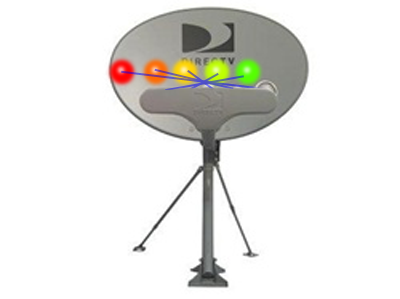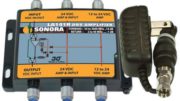Your standard DIRECTV dish is just a shade over a yard wide. That’s about double the width of the original DIRECTV dishes. Everything else in the world gets smaller, but some how dishes get bigger? How can that be?
The answer, to anyone with some knowledge of the DIRECTV world, is clear: Where once every single DIRECTV channel resided on one satellite, now there is a whole fleet of them occupying four different orbital locations for US English language programming alone. There’s a fifth location that is used for international programs but it requires a separate dish. Pointing at all those locations at the same time requires a bit of fancy math where signals from different locations bounce off the back and land on the front of the dish where they’re received. I did this diagram several years ago and it still shows the problem.

That extra big dish was originally needed for DIRECTV’s satellite locations at 110 West and 119 West. Those locations are quite a bit off center from DIRECTV’s main location at 101 West.
There’s a bit of hope for a smaller dish, though, since the 110 location is completely out of service. The lone satellite at the 119 degree location is only used for standard definition service in a few markets. It’s due to be phased out as well. So it’s possible we could see a smaller dish in the future.
Possible, yes. Likely, no.
The thing about satellite dishes is that they have to be cheap and reliable. Residential customers generally don’t pay for their satellite dishes, yet they have to work through harsh weather for years and years. Over the last decade, DIRECTV has engineered the standard Slimline dish to be inexpensive, easy to assemble, and reliable. Unless there’s a reason to re-engineer them, they aren’t going to change.
The current dish size is actually dictated by an FCC rule saying that homeowners’ associations can’t stop you from putting up any antenna or dish smaller than 1 meter (39 inches) in all directions. So the DIRECTV Slimline dish is made to be as big as it can be and still fit under that rule. There’s no real economic pressure to make it smaller for most home installs. That dish on the roof may look a little ugly to you, but most folks agree that making it smaller won’t make it look better
Talking about marine and RV
It’s one thing if you have DIRECTV service at home. But RVs and small boats just can’t deal with such a large dish while they are moving. Some RVs do have multi-satellite dishes that can be used while you’re parked. The problem is that when you take a multi-satellite dish and put in all the electronics and the big white cover, it gets too big for an RV. Intellian’s s6HD is so tall that the RV might not fit under some overpasses if it were mounted on the roof.
Boat owners always need in-motion dishes, since of course there’s no such thing as a boat that stays perfectly still in the water. Again, the multi-satellite dish is too big and heavy for some smaller craft. It’s also much more expensive.
The makers of these dishes have worked for years to simplify them and make them smaller. There’s still hope that they’ll come up with a breakthrough but there’s something better on the horizon. DIRECTV will be moving more national HD programming back to its 101 satellite location in the coming years. This will be done to satisfy contracts that are in place. It will also give people in wetter regions a better opportunity to get strong signals. Right now there are a handful of HD channels at the 101 location, but as standard-definition channels vacate that satellite that number will grow. That’s the real solution
Be ready for the next chapter
Now’s the time to take a look at your satellite equipment and see if it’s ready for the next generation of services! Call the experts at Signal Connect and we can help! We have trained technicians who are ready to give you the advice you need. We’re here for you during East Coast business hours. Call us at 888-233-7563. If it’s after hours, fill out the form below. We’ll get back to you quickly!




